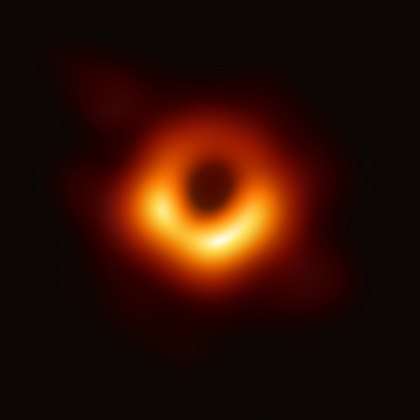Nonsingular black hole models
A nonsingular black hole model is a mathematical theory of black holes that avoids certain theoretical problems with the standard black hole model, including information loss and the unobservable nature of the black hole event horizon.
Avoiding paradoxes in the standard black hole model
For a black hole to physically exist as a solution to Einstein's equation, it must form an event horizon in finite time relative to outside observers. This requires an accurate theory of black hole formation, of which several have been proposed. In 2007, Shuan Nan Zhang of Tsinghua University proposed a model in which the event horizon of a potential black hole only forms (or expands) after an object falls into the existing horizon, or after the horizon has exceeded the critical density. In other words, an infalling object causes the horizon of a black hole to expand, which only occurs after the object has fallen into the hole, allowing an observable horizon in finite time.[1][2] This solution does not solve the information paradox, however.
Alternative black hole models
Nonsingular black hole models have been proposed since theoretical problems with black holes were first realized. Today some of the most viable candidates for the end result of the collapse of a star with mass well above the Chandrasekhar limit include the gravastar and the dark energy star.
While black holes were a well-established part of mainstream physics for most of the end of the 20th century, alternative models received new attention when models proposed by George Chapline and later by Lawrence Krauss, Dejan Stojkovic, and Tanmay Vachaspati of Case Western Reserve University showed in several separate models that black hole horizons could not form.[3][4]
Such research has attracted much media attention,[5] as black holes have long captured the imagination of both scientists and the public for both their innate simplicity and mysteriousness. The recent theoretical results have therefore undergone much scrutiny and most of them are now ruled out by theoretical studies. For example, several alternative black hole models were shown to be unstable in extremely fast rotation,[6] which, by conservation of angular momentum, would be a not unusual physical scenario for a collapsed star (see pulsar). Nevertheless, the existence of a stable model of a nonsingular black hole is still an open question.
Hayward metric
The Hayward metric is the simplest description of a black hole which is non-singular. The metric was written down by Sean Hayward as the minimal model which is regular, static, spherically symmetric and asymptotically flat.[7]
References
- Zhang, Shuang Nan; Tang, Sumin (2007-07-06). "Witnessing matter falling into a black hole by a distant observer". Tsinghua University. Retrieved 2007-11-03.
- Zhang, Shuang Nan; Liu, Yuan (October 2007). "Observe matter falling into a black hole". AIP Conf. Proc. 968: 384–391. arXiv:0710.2443. doi:10.1063/1.2840436.
- Chapline, George (July 1998). "The Black Hole Information Puzzle and Evidence for a Cosmological Constant". arXiv:hep-th/9807175.
- Vachaspati, Tanmay; Dejan Stojkovic; Lawrence M. Krauss (June 2007). "Observation of Incipient Black Holes and the Information Loss Problem". Phys. Rev. D. 76 (2). arXiv:gr-qc/0609024. Bibcode:2007PhRvD..76b4005V. doi:10.1103/PhysRevD.76.024005.
- Rockets, Rusty (2007-06-22). "Rethinking Black Holes". Science A Gogo. Retrieved 2007-11-03.
- Cardoso, Vitor; Paolo Pani; Mariano Cadoni; Marco Cavaglia (September 2007). "Ergoregion instability rules out black hole doubles". Phys. Rev. D. 77 (12). arXiv:0709.0532. Bibcode:2008PhRvD..77l4044C. doi:10.1103/PhysRevD.77.124044.
- Hayward, Sean A. (26 January 2006). "Formation and evaporation of non-singular black holes". Physical Review Letters. 96 (3). arXiv:gr-qc/0506126. doi:10.1103/PhysRevLett.96.031103.
External links
- Black holes don't exist, Case physicists report
- George Chapline (1998). "The Black Hole Information Puzzle and Evidence for a Cosmological Constant". arXiv:hep-th/9807175.
- Abhas Mitra (2005). "Comments on the proposal of Dark Energy Stars by Chapline". arXiv:astro-ph/0504384.
